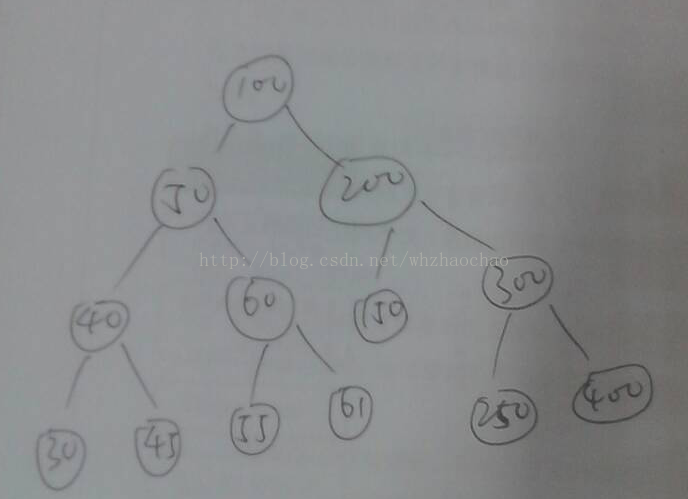1.数据类型定义
在代码中为了清楚的表示一些错误和函数运行状态,我们预先定义一些变量来表示这些状态。在head.h头文件中有如下定义:
//定义数据结构中要用到的一些变量和类型
#ifndef HEAD_H
#define HEAD_H
#include <stdio.h>
#include <malloc.h>
#include <stdlib.h>
#include <math.h>
#define TRUE 1
#define FALSE 0
#define OK 1
#define ERROR 0
#define INFEASIBLE -1
#define OVERFLOW -2 //分配内存出错
typedef int Status; //函数返回值类型
typedef int ElemType; //用户定义的数据类型
#endif- 1.
- 2.
- 3.
- 4.
- 5.
- 6.
- 7.
- 8.
- 9.
- 10.
- 11.
- 12.
- 13.
- 14.
- 15.
- 16.
- 17.
- 18.
- 19.
- 20.
2.数据结构实现
3.二叉树代码实现
BiTree.h代码如下:
#ifndef BITREE_H
#define BITREE_H
#include "head.h"
typedef struct BiNode{
ElemType data;
struct BiNode *left,*right;
}BiNode,*pBiNode;
Status InsertRight(pBiNode &root,ElemType e);
Status InsertLeft(pBiNode &root,ElemType e);
Status InitBiTree(pBiNode &tree){
tree=(pBiNode)malloc(sizeof(BiNode));
if(!tree) return OVERFLOW;
tree->data=-999999;
tree->left=NULL;
tree->right=NULL;
return OK;
}
Status BiTreeEmpty(pBiNode root){
if(root==NULL) return ERROR;
return root->left==root->right && root->data==-999999;
}
Status HasNoNode(pBiNode root){
if(root==NULL) return ERROR;
return root->left==root->right ;
}
Status CreatTreeNode(pBiNode &node,ElemType e){
node=(pBiNode)malloc(sizeof(BiNode));
if(!node) return OVERFLOW;
node->data=e;
node->left=NULL;
node->right=NULL;
return OK;
}
Status InsertRight(pBiNode &root,ElemType e){
if(root->right==NULL){
if(e>root->data){
pBiNode p;
CreatTreeNode(p,e);
root->right=p;
return OK;
}else{
pBiNode p;
CreatTreeNode(p,e);
root->left=p;
return OK;
}
}else{
e>root->data? InsertRight(root->right,e):InsertLeft(root,e);
}
}
Status InsertLeft(pBiNode &root,ElemType e){
if(root->left==NULL){
if(e>root->data){
pBiNode p;
CreatTreeNode(p,e);
root->right=p;
return OK;
}else{
pBiNode p;
CreatTreeNode(p,e);
root->left=p;
return OK;
}
}else{
e<=root->data?InsertLeft(root->left,e):InsertRight(root,e);
}
}
Status InsertTree(pBiNode &root,ElemType e){
if(BiTreeEmpty(root)){
root->data=e;
return true;
}
if(e>root->data){
InsertRight(root,e);
}else{
InsertLeft(root,e);
}
}
Status CreateBiTree(pBiNode &root,ElemType *a,int n){
for (int i=0;i<n;i++)
{
InsertTree(root,a[i]);
}
return true;
}
Status print(ElemType e ){
printf("%d ",e);
return true;
}
Status PreOrderTraverse(pBiNode root,Status(*p)(int)){
if(root){
(*p)(root->data);
PreOrderTraverse(root->left,p);
PreOrderTraverse(root->right,p);
}
return OK;
}
Status MiddleOrderTraverse(pBiNode root,Status(*p)(int)){
if(root){
MiddleOrderTraverse(root->left,p);
(*p)(root->data);
MiddleOrderTraverse(root->right,p);
}
return OK;
}
Status AfterOrderTraverse(pBiNode root,Status(*p)(int)){
if(root){
AfterOrderTraverse(root->left,p);
AfterOrderTraverse(root->right,p);
(*p)(root->data);
}
return OK;
}
Status ClearBiTree(pBiNode &root){
if(root){
ClearBiTree(root->left);
ClearBiTree(root->right);
free(root);
root==NULL;
}
return OK;
}
#endif- 1.
- 2.
- 3.
- 4.
- 5.
- 6.
- 7.
- 8.
- 9.
- 10.
- 11.
- 12.
- 13.
- 14.
- 15.
- 16.
- 17.
- 18.
- 19.
- 20.
- 21.
- 22.
- 23.
- 24.
- 25.
- 26.
- 27.
- 28.
- 29.
- 30.
- 31.
- 32.
- 33.
- 34.
- 35.
- 36.
- 37.
- 38.
- 39.
- 40.
- 41.
- 42.
- 43.
- 44.
- 45.
- 46.
- 47.
- 48.
- 49.
- 50.
- 51.
- 52.
- 53.
- 54.
- 55.
- 56.
- 57.
- 58.
- 59.
- 60.
- 61.
- 62.
- 63.
- 64.
- 65.
- 66.
- 67.
- 68.
- 69.
- 70.
- 71.
- 72.
- 73.
- 74.
- 75.
- 76.
- 77.
- 78.
- 79.
- 80.
- 81.
- 82.
- 83.
- 84.
- 85.
- 86.
- 87.
- 88.
- 89.
- 90.
- 91.
- 92.
- 93.
- 94.
- 95.
- 96.
- 97.
- 98.
- 99.
- 100.
- 101.
- 102.
- 103.
- 104.
- 105.
- 106.
- 107.
- 108.
- 109.
- 110.
- 111.
- 112.
- 113.
- 114.
- 115.
- 116.
- 117.
- 118.
- 119.
- 120.
- 121.
- 122.
- 123.
- 124.
- 125.
- 126.
- 127.
- 128.
- 129.
- 130.
- 131.
- 132.
- 133.
- 134.
- 135.
- 136.
- 137.
- 138.
- 139.
- 140.
- 141.
- 142.
- 143.
- 144.
- 145.
- 146.
4.测试代码
#include "BiTree.h"
void main(){
ElemType a[14]={100,50,200,40,30,45,60,55,61,200,150,300,250,400};
pBiNode root;
InitBiTree(root);
CreateBiTree(root,a,14);
printf("前序:");
PreOrderTraverse(root,print);
printf("\n中序:");
MiddleOrderTraverse(root,print);
printf("\n后序:");
AfterOrderTraverse(root,print);
ClearBiTree(root);
}- 1.
- 2.
- 3.
- 4.
- 5.
- 6.
- 7.
- 8.
- 9.
- 10.
- 11.
- 12.
- 13.
- 14.
- 15.
- 16.
- 17.
- 18.
- 19.
- 20.
5.插入数据如下:

6.测试结果





















 200
200

 被折叠的 条评论
为什么被折叠?
被折叠的 条评论
为什么被折叠?








